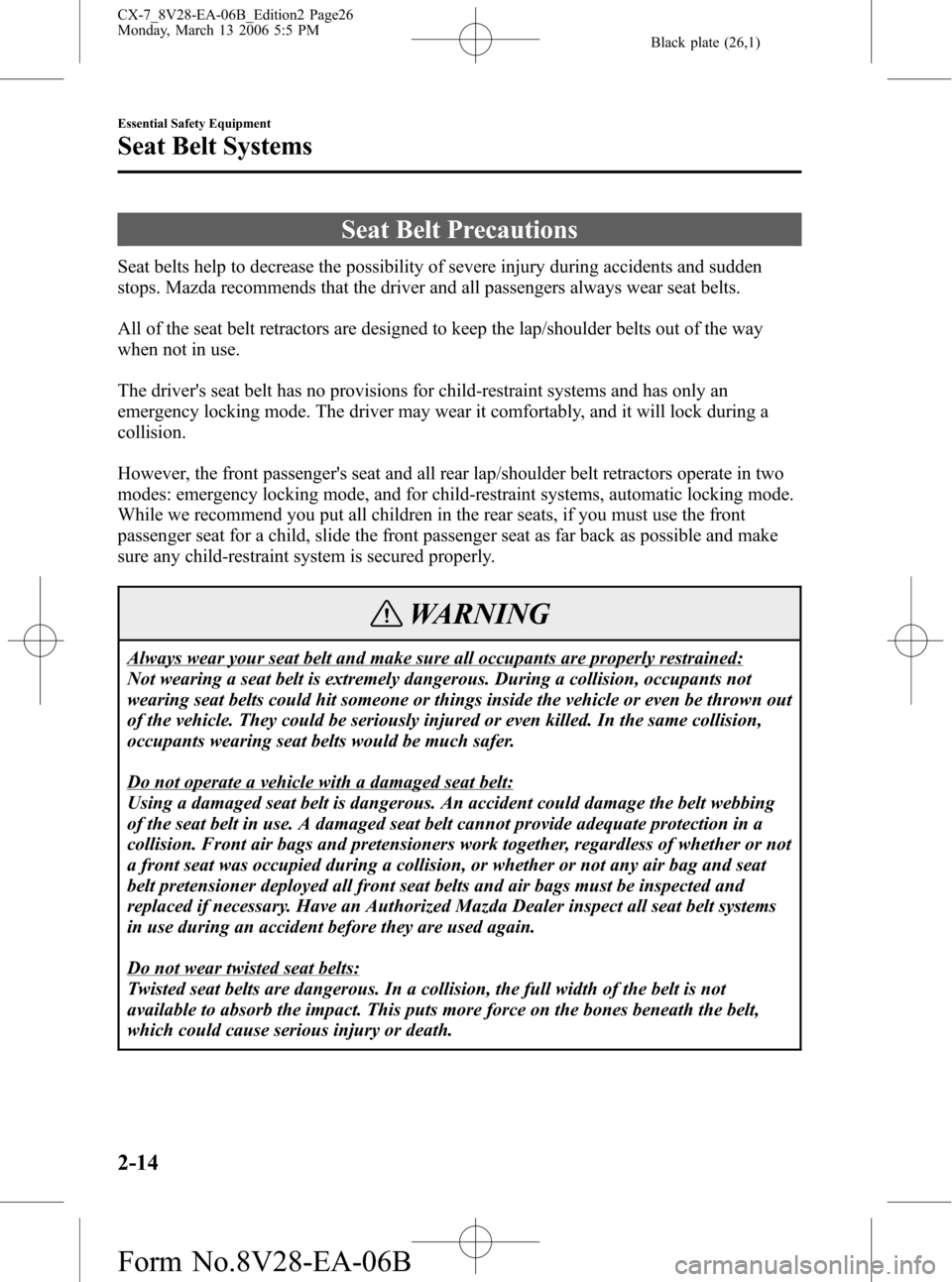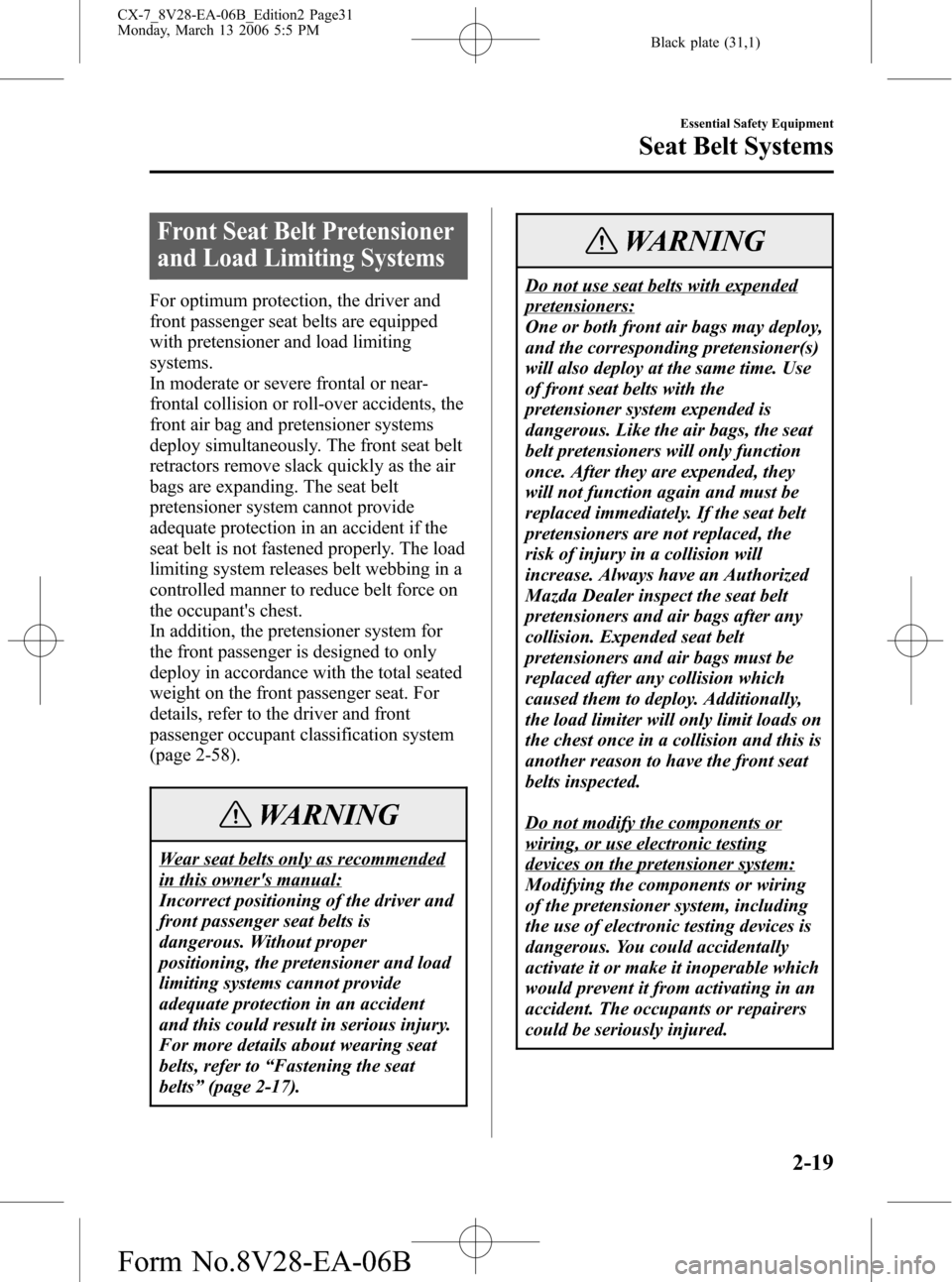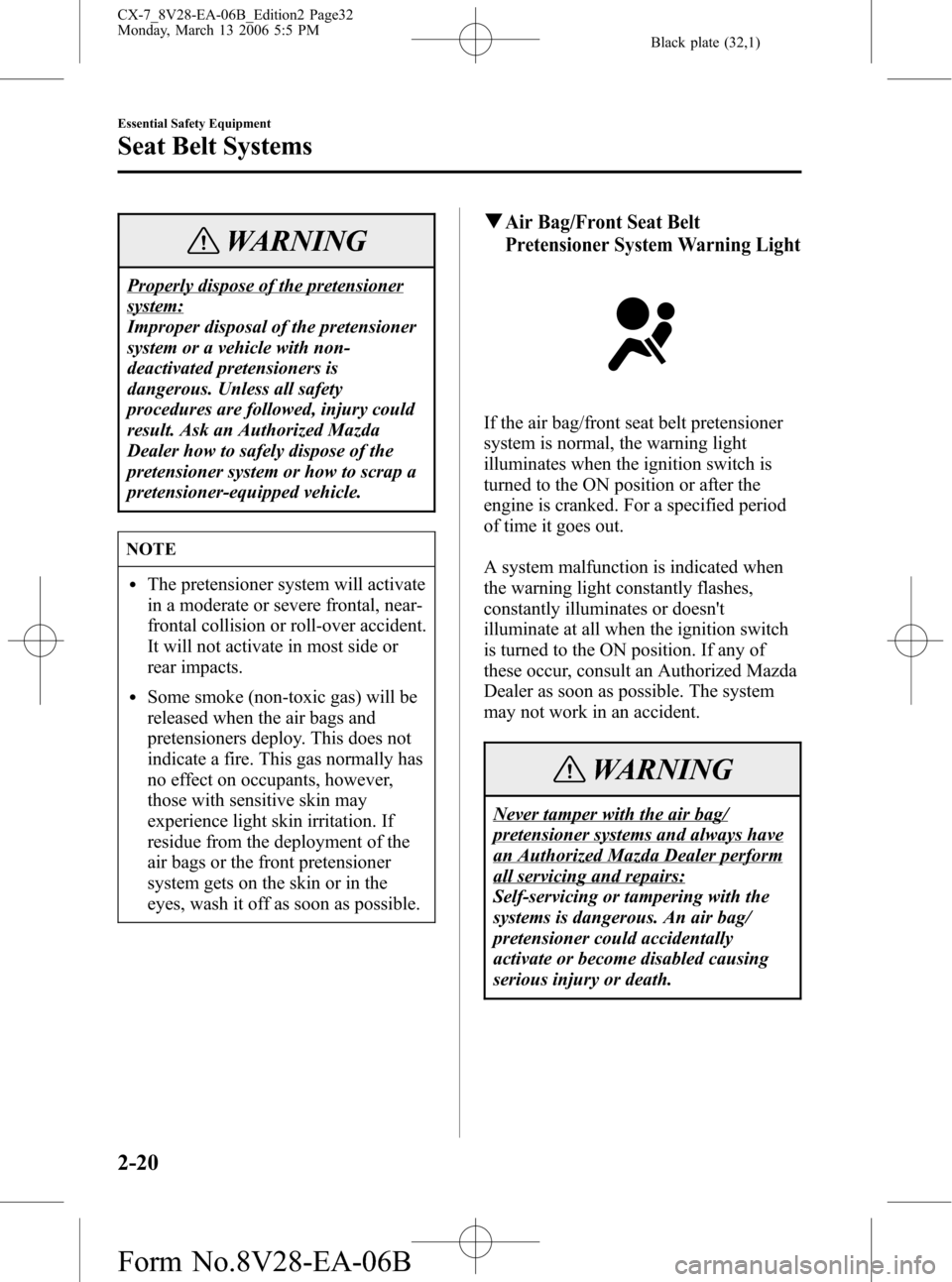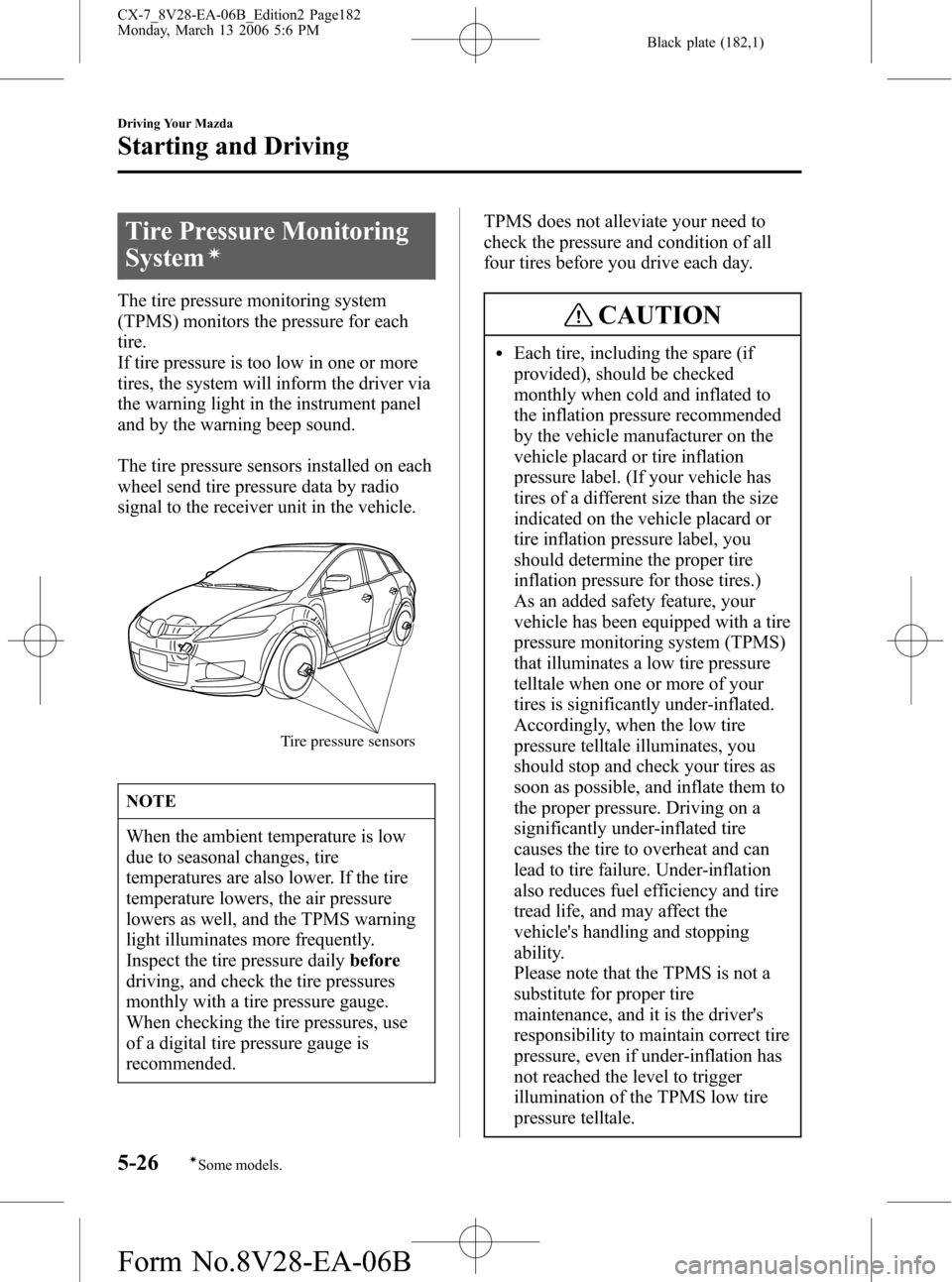ECO mode MAZDA MODEL CX-7 2007 Owners Manual (in English)
[x] Cancel search | Manufacturer: MAZDA, Model Year: 2007, Model line: MODEL CX-7, Model: MAZDA MODEL CX-7 2007Pages: 406, PDF Size: 6.11 MB
Page 3 of 406

Black plate (3,1)
Thank you for choosing a Mazda. We at Mazda design and build vehicles with complete
customer satisfaction in mind.
To help ensure enjoyable and trouble-free operation of your Mazda, read this manual
carefully and follow its recommendations.
An Authorized Mazda Dealer knows your vehicle best. So when maintenance or service is
necessary, that's the place to go.
Our nationwide network of Mazda professionals is dedicated to providing you with the best
possible service.
We assure you that all of us at Mazda have an ongoing interest in your motoring pleasure
and in your full satisfaction with your Mazda product.
Mazda Motor Corporation
HIROSHIMA, JAPAN
Important Notes About This Manual
Keep this manual in the glove box as a handy reference for the safe and enjoyable use of your Mazda. Should you
resell the vehicle, leave this manual with it for the next owner.
All specifications and descriptions are accurate at the time of printing. Because improvement is a constant goal at
Mazda, we reserve the right to make changes in specifications at any time without notice and without obligation.
Event Data Recorder
This vehicle is equipped with an event data recorder. In the event of a crash, this device records data related to
vehicle dynamics and safety systems for a short period of time. These data can help provide a better
understanding of the circumstances in which crashes and injuries occur and lead to the designing of safer
vehicles.
Air Conditioning and the Environment
Your Mazda's genuine air conditioner is filled with HFC134a (R134a), a refrigerant that has been found not to
damage the earth's ozone layer. If the air conditioner does not operate properly, consult an Authorized Mazda
Dealer.
Please be aware that this manual applies to all models, equipment and options. As a result, you may find
some explanations for equipment not installed on your vehicle.
©2006 Mazda Motor Corporation
Printed in Japan Apr. 2006(Print2)
A Word to Mazda Owners
CX-7_8V28-EA-06B_Edition2 Page3
Monday, March 13 2006 5:4 PM
Form No.8V28-EA-06B
Page 26 of 406

Black plate (26,1)
Seat Belt Precautions
Seat belts help to decrease the possibility of severe injury during accidents and sudden
stops. Mazda recommends that the driver and all passengers always wear seat belts.
All of the seat belt retractors are designed to keep the lap/shoulder belts out of the way
when not in use.
The driver's seat belt has no provisions for child-restraint systems and has only an
emergency locking mode. The driver may wear it comfortably, and it will lock during a
collision.
However, the front passenger's seat and all rear lap/shoulder belt retractors operate in two
modes: emergency locking mode, and for child-restraint systems, automatic locking mode.
While we recommend you put all children in the rear seats, if you must use the front
passenger seat for a child, slide the front passenger seat as far back as possible and make
sure any child-restraint system is secured properly.
WARNING
Always wear your seat belt and make sure all occupants are properly restrained:
Not wearing a seat belt is extremely dangerous. During a collision, occupants not
wearing seat belts could hit someone or things inside the vehicle or even be thrown out
of the vehicle. They could be seriously injured or even killed. In the same collision,
occupants wearing seat belts would be much safer.
Do not operate a vehicle with a damaged seat belt:
Using a damaged seat belt is dangerous. An accident could damage the belt webbing
of the seat belt in use. A damaged seat belt cannot provide adequate protection in a
collision. Front air bags and pretensioners work together, regardless of whether or not
a front seat was occupied during a collision, or whether or not any air bag and seat
belt pretensioner deployed all front seat belts and air bags must be inspected and
replaced if necessary. Have an Authorized Mazda Dealer inspect all seat belt systems
in use during an accident before they are used again.
Do not wear twisted seat belts:
Twisted seat belts are dangerous. In a collision, the full width of the belt is not
available to absorb the impact. This puts more force on the bones beneath the belt,
which could cause serious injury or death.
2-14
Essential Safety Equipment
Seat Belt Systems
CX-7_8V28-EA-06B_Edition2 Page26
Monday, March 13 2006 5:5 PM
Form No.8V28-EA-06B
Page 31 of 406

Black plate (31,1)
Front Seat Belt Pretensioner
and Load Limiting Systems
For optimum protection, the driver and
front passenger seat belts are equipped
with pretensioner and load limiting
systems.
In moderate or severe frontal or near-
frontal collision or roll-over accidents, the
front air bag and pretensioner systems
deploy simultaneously. The front seat belt
retractors remove slack quickly as the air
bags are expanding. The seat belt
pretensioner system cannot provide
adequate protection in an accident if the
seat belt is not fastened properly. The load
limiting system releases belt webbing in a
controlled manner to reduce belt force on
the occupant's chest.
In addition, the pretensioner system for
the front passenger is designed to only
deploy in accordance with the total seated
weight on the front passenger seat. For
details, refer to the driver and front
passenger occupant classification system
(page 2-58).
WARNING
Wear seat belts only as recommended
in this owner's manual:
Incorrect positioning of the driver and
front passenger seat belts is
dangerous. Without proper
positioning, the pretensioner and load
limiting systems cannot provide
adequate protection in an accident
and this could result in serious injury.
For more details about wearing seat
belts, refer to“Fastening the seat
belts”(page 2-17).
WARNING
Do not use seat belts with expended
pretensioners:
One or both front air bags may deploy,
and the corresponding pretensioner(s)
will also deploy at the same time. Use
of front seat belts with the
pretensioner system expended is
dangerous. Like the air bags, the seat
belt pretensioners will only function
once. After they are expended, they
will not function again and must be
replaced immediately. If the seat belt
pretensioners are not replaced, the
risk of injury in a collision will
increase. Always have an Authorized
Mazda Dealer inspect the seat belt
pretensioners and air bags after any
collision. Expended seat belt
pretensioners and air bags must be
replaced after any collision which
caused them to deploy. Additionally,
the load limiter will only limit loads on
the chest once in a collision and this is
another reason to have the front seat
belts inspected.
Do not modify the components or
wiring, or use electronic testing
devices on the pretensioner system:
Modifying the components or wiring
of the pretensioner system, including
the use of electronic testing devices is
dangerous. You could accidentally
activate it or make it inoperable which
would prevent it from activating in an
accident. The occupants or repairers
could be seriously injured.
Essential Safety Equipment
Seat Belt Systems
2-19
CX-7_8V28-EA-06B_Edition2 Page31
Monday, March 13 2006 5:5 PM
Form No.8V28-EA-06B
Page 32 of 406

Black plate (32,1)
WARNING
Properly dispose of the pretensioner
system:
Improper disposal of the pretensioner
system or a vehicle with non-
deactivated pretensioners is
dangerous. Unless all safety
procedures are followed, injury could
result. Ask an Authorized Mazda
Dealer how to safely dispose of the
pretensioner system or how to scrap a
pretensioner-equipped vehicle.
NOTE
lThe pretensioner system will activate
in a moderate or severe frontal, near-
frontal collision or roll-over accident.
It will not activate in most side or
rear impacts.
lSome smoke (non-toxic gas) will be
released when the air bags and
pretensioners deploy. This does not
indicate a fire. This gas normally has
no effect on occupants, however,
those with sensitive skin may
experience light skin irritation. If
residue from the deployment of the
air bags or the front pretensioner
system gets on the skin or in the
eyes, wash it off as soon as possible.
qAir Bag/Front Seat Belt
Pretensioner System Warning Light
If the air bag/front seat belt pretensioner
system is normal, the warning light
illuminates when the ignition switch is
turned to the ON position or after the
engine is cranked. For a specified period
of time it goes out.
A system malfunction is indicated when
the warning light constantly flashes,
constantly illuminates or doesn't
illuminate at all when the ignition switch
is turned to the ON position. If any of
these occur, consult an Authorized Mazda
Dealer as soon as possible. The system
may not work in an accident.
WARNING
Never tamper with the air bag/
pretensioner systems and always have
an Authorized Mazda Dealer perform
all servicing and repairs:
Self-servicing or tampering with the
systems is dangerous. An air bag/
pretensioner could accidentally
activate or become disabled causing
serious injury or death.
2-20
Essential Safety Equipment
Seat Belt Systems
CX-7_8V28-EA-06B_Edition2 Page32
Monday, March 13 2006 5:5 PM
Form No.8V28-EA-06B
Page 109 of 406

Black plate (109,1)
qLuggage Compartment
WARNING
Do not place luggage or other cargo
on top of the luggage compartment
cover:
Placing luggage or other cargo on top
of the luggage compartment cover is
dangerous. During sudden braking or
a collision, the cargo could become a
projectile that could hit and injure
someone. The vehicle has a light
weight luggage compartment cover to
keep the contents of your luggage area
out of sight; it will not retain heavy
objects that are not tied down in an
accident such as a rollover. Tie down
all heavy objects, whether luggage or
cargo, using the tie down hooks.
Make sure luggage and cargo is
secured before driving:
Not securing cargo while driving is
dangerous as it could move or be
crushed during sudden braking or a
collision and cause injury.
CAUTION
Make sure the luggage compartment
cover is firmly secured. If it is not
firmly secured, it could unexpectedly
disengage resulting in injury.
Luggage compartment coverí
Installing the cover
1. Insert the left end of the retractor bar
into the notch.
2. Squeeze the spring holder on right end
of the retractor bar inward, then insert
it into the notch.
Knowing Your Mazda
Doors and Locks
3-33íSome models. CX-7_8V28-EA-06B_Edition2 Page109
Monday, March 13 2006 5:5 PM
Form No.8V28-EA-06B
Page 132 of 406

Black plate (132,1)
Theft-Deterrent Systemí
The theft-deterrent system is designed to
prevent your vehicle or its contents from
being stolen when all doors, hood, and
liftgate are locked.
If forcible entry is attempted, the system
sounds the horn and flashes the hazard
warning lights.
NOTE
lThe theft-deterrent system operates
with the key or the keyless entry
system transmitter.
l(With advanced key)
The theft-deterrent system can also
be operated using a request switch or
the start knob.
The system operates only when the
driver is in the vehicle or within
operational range while the advanced
key is being carried.
lThe system will not function unless
it is properly armed. To properly
secure the vehicle, always make sure
all windows are completely closed
and all doors and the liftgate are
locked before leaving the vehicle.
Remember to take your key and
transmitter.
qOperation
System triggering conditions
The horn sounds intermittently and the
hazard warning lights flash for about 25
seconds when the system is triggered by
any one of the following:
lForcing open a door, the hood or the
liftgate.
lUnlocking a door with the inside door-
lock knob.
lUnlocking a door with the door lock
switch.
lOpening a door by operating an inside
door-lock knob.
lOpening the hood by operating the
hood release handle.
If the system is triggered again, the lights
and horn will activate until a door or the
liftgate is unlocked with the key or with
the transmitter.
(With advanced key)
The lights and horn can also be
deactivated by pressing a request switch.
qHow to Arm the System
1. Remove the key from the ignition
switch.
(With advanced key)
Turn the start knob to the LOCK
position.
2. Make sure the hood is closed. Close
and lock all doors and the liftgate from
the outside using the key or press the
lock button on your keyless entry
system transmitter.
(With advanced key)
Press a request switch or the lock
button on the transmitter.
The hazard warning lights will flash
once to indicate that the system is
armed.
(Without advanced key)
The following method will also arm the
theft-deterrent system:
Close the hood and the liftgate . Press
the area on the door-lock switch
marked“
”once. Close all doors.
3-56
Knowing Your Mazda
íSome models.
Security System
CX-7_8V28-EA-06B_Edition2 Page132
Monday, March 13 2006 5:5 PM
Form No.8V28-EA-06B
Page 169 of 406

Black plate (169,1)
NOTE
lIf the gears cannot be shifted down
when driving at higher speeds, the
gear position indicator will flash
twice to signal that the gears cannot
be shifted down.
lIf the automatic transaxle fluid (ATF)
temperature becomes too high, there
is the possibility that the transaxle
will switch to automatic shift mode,
canceling manual shift mode and
turning off the gear position indicator
illumination. This is a normal
function to protect the AT. After the
ATF temperature has decreased, the
gear position indicator illumination
turns back on and driving in manual
shift mode is restored.
Shifting
Manually Shifting up
(M1→M2→M3→M4→M5→M6)
To shift up to a higher gear, tap the shift
lever back (
) once.
NOTE
lWhen driving slowly, the gears may
not shift up depending on vehicle
speed.
lIn manual shift mode, gears do not
shift up automatically. Don't run the
engine with the tachometer needle in
the RED ZONE. If the tachometer
needle enters the RED ZONE, you
may feel engine-braking because the
fuel delivery will be stopped to
protect the engine. However, this
does not indicate an abnormality.
lWhen depressing the accelerator
fully, the transaxle will shift to a
lower gear, depending on vehicle
speed.
Manually Shifting down
(M6→M5→M4→M3→M2→M1)
To shift down to a lower gear, tap the shift
lever forward (
) once.
Driving Your Mazda
Starting and Driving
5-13
CX-7_8V28-EA-06B_Edition2 Page169
Monday, March 13 2006 5:6 PM
Form No.8V28-EA-06B
Page 170 of 406

Black plate (170,1)
WARNING
Do not use engine braking on slippery
road surfaces or at high speeds:
Shifting down while driving on wet,
snowy, or frozen roads, or while
driving at high speeds causes sudden
engine braking, which is dangerous.
The sudden change in tire speed could
cause the tires to skid. This could lead
to loss of vehicle control and an
accident.
NOTE
lWhen driving at high speeds, the
gear may not shift down depending
on vehicle speed.
lDuring deceleration, the gear may
automatically shift down depending
on vehicle speed.
lWhen depressing the accelerator
fully, the transaxle will shift to a
lower gear, depending on vehicle
speed.
Second gear fixed mode
When the shift lever is tapped back (
)
while the vehicle is stopped, the transaxle
is set in the second gear fixed mode. The
gear is fixed in second while in this mode
for easier starting and driving on slippery
roads. If the shift lever is tapped back (
)
or forward (
) while in the second gear
fixed mode, the mode will be canceled.
Shifting specification
Shifting up
If the vehicle speed is lower than the
speed specified for each gear, the gear
cannot be shifted up to a higher gear.
Gear Vehicle speed
M1→M2You can shift up to M2 whether the
vehicle is stopped or moving.
M2→M3 9 km/h (6 mph)
M3→M4 26 km/h (16 mph)
M4→M5 36 km/h (22 mph)
M5→M6 53 km/h (33 mph)
Shifting down
If the vehicle speed is higher than the
speed specified for each gear, the gear
cannot be shifted down to a lower gear.
Gear Vehicle speed
M6→M5 230 km/h (143 mph)
M5→M4 182 km/h (113 mph)
M4→M3 135 km/h (83 mph)
M3→M2 86 km/h (53 mph)
M2→M1 44 km/h (27 mph)
During deceleration, the gears shift down
automatically when speed is reduced to
the following:
Gear Vehicle speed
M6→M5 52 km/h (32 mph)
M5→M4 34 km/h (21 mph)
M4→M3 25 km/h (15 mph)
M3 or M2→M1 8 km/h (5 mph)
NOTE
The gear does not shift down to M1
automatically while in the second gear
fixed mode.
5-14
Driving Your Mazda
Starting and Driving
CX-7_8V28-EA-06B_Edition2 Page170
Monday, March 13 2006 5:6 PM
Form No.8V28-EA-06B
Page 172 of 406

Black plate (172,1)
Power Steering
Power steering is only operable when the
engine is running. If the engine is off or if
the power steering system is inoperable,
you can still steer, but it requires more
physical effort.
If the steering feels rigid during normal
driving, consult an Authorized Mazda
Dealer.
CAUTION
Never hold the steering wheel to the
extreme left or right for more than 5
seconds with the engine running.
This could damage the power steering
system.
All-Wheel Drive (AWD)
Operation
í
AWD provides excellent driveability on
snow-covered and ice-packed roads, sand
and mud, as well as on steep slopes and
other slippery surfaces.
qAWD Driving
WARNING
Avoid sharp turns, excessive speed and
abrupt maneuvers when driving this
vehicles:
Vehicles with a higher center of
gravity such as utility and AWD
vehicles handle differently than
vehicles with a lower center of gravity.
Utility and AWD vehicles are not
designed for cornering at speeds as
high as passenger cars any more than
low-slung sport cars are designed to
perform satisfactorily under off-road
conditions. Failure to drive cautiously
could result in an increase risk of loss
of vehicle control, vehicle roll-over,
personal injury and death.
Utility vehicles have a significantly
higher rollover rate than other types of
vehicles.
5-16
Driving Your Mazda
íSome models.
Starting and Driving
CX-7_8V28-EA-06B_Edition2 Page172
Monday, March 13 2006 5:6 PM
Form No.8V28-EA-06B
Page 182 of 406

Black plate (182,1)
Tire Pressure Monitoring
System
í
The tire pressure monitoring system
(TPMS) monitors the pressure for each
tire.
If tire pressure is too low in one or more
tires, the system will inform the driver via
the warning light in the instrument panel
and by the warning beep sound.
The tire pressure sensors installed on each
wheel send tire pressure data by radio
signal to the receiver unit in the vehicle.
Tire pressure sensors
NOTE
When the ambient temperature is low
due to seasonal changes, tire
temperatures are also lower. If the tire
temperature lowers, the air pressure
lowers as well, and the TPMS warning
light illuminates more frequently.
Inspect the tire pressure dailybefore
driving, and check the tire pressures
monthly with a tire pressure gauge.
When checking the tire pressures, use
of a digital tire pressure gauge is
recommended.TPMS does not alleviate your need to
check the pressure and condition of all
four tires before you drive each day.
CAUTION
lEach tire, including the spare (if
provided), should be checked
monthly when cold and inflated to
the inflation pressure recommended
by the vehicle manufacturer on the
vehicle placard or tire inflation
pressure label. (If your vehicle has
tires of a different size than the size
indicated on the vehicle placard or
tire inflation pressure label, you
should determine the proper tire
inflation pressure for those tires.)
As an added safety feature, your
vehicle has been equipped with a tire
pressure monitoring system (TPMS)
that illuminates a low tire pressure
telltale when one or more of your
tires is significantly under-inflated.
Accordingly, when the low tire
pressure telltale illuminates, you
should stop and check your tires as
soon as possible, and inflate them to
the proper pressure. Driving on a
significantly under-inflated tire
causes the tire to overheat and can
lead to tire failure. Under-inflation
also reduces fuel efficiency and tire
tread life, and may affect the
vehicle's handling and stopping
ability.
Please note that the TPMS is not a
substitute for proper tire
maintenance, and it is the driver's
responsibility to maintain correct tire
pressure, even if under-inflation has
not reached the level to trigger
illumination of the TPMS low tire
pressure telltale.
5-26
Driving Your Mazda
íSome models.
Starting and Driving
CX-7_8V28-EA-06B_Edition2 Page182
Monday, March 13 2006 5:6 PM
Form No.8V28-EA-06B